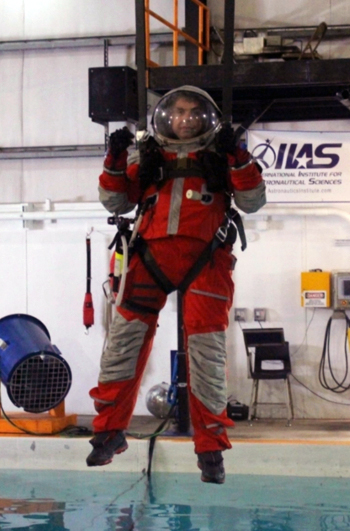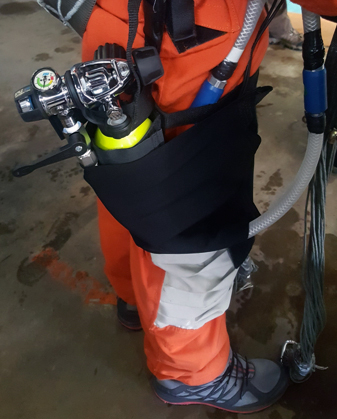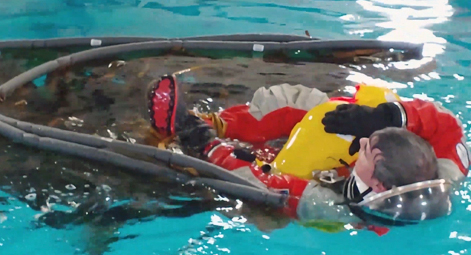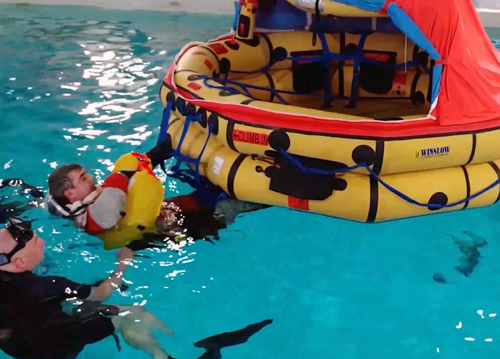Posey's Moonshot
Astronaut Survival Training: Parachuting into the Ocean in a Spacesuit
For an astronaut in training, parachuting out of a disabled spacecraft ranks high on the list of skills you hopefully never have to use in real life.
One of the things about spaceflight that isn't particularly fun to think about is that going into space is dangerous. When you launch into space, you are essentially riding on a controlled explosion. Never mind that space itself is a lethal environment, and you are completely dependent on the space vehicle and/or your spacesuit to keep you alive.
Because spaceflight is so dangerous, the bulk of the training I have done has focused on contingencies for when things go wrong. For example, there are situations that may require you to parachute out of a disabled spacecraft after it has reentered the Earth's atmosphere.
Since the vast majority of the Earth's surface is covered by water, I have spent a lot of time learning how to safely parachute into the water while wearing a spacesuit.
Thankfully, nobody has ever made me do a real parachute jump into the water. All of my jump practice has taken place in a swimming pool, as shown in Figure 1. The idea is to be able to learn the procedures in a safe and controlled environment, rather than introducing unnecessary risks by jumping into the ocean.
 Figure 1: This is how I have practiced parachuting into the water.
Figure 1: This is how I have practiced parachuting into the water.
The jump itself really isn't all that different from any other parachute jump. The biggest difference is that you have to disconnect the spacesuit from the vehicle's life support system, and then switch over to the suit's own life support before taking the plunge. Unlike the spacesuits that are used for spacewalks, the suits that are worn during launch and reentry are not equipped with any sort of long-duration life support. Instead, emergency air is supplied by a small cylinder that some people call the "green apple" (because of its size and color). The tiny air cylinder gives you enough air to pressurize the spacesuit and to breathe during your descent, but is nearly depleted by the time you land.
 Figure 2: The green apple, strapped to my leg, acts as an emergency air supply.
Figure 2: The green apple, strapped to my leg, acts as an emergency air supply.
Once you land in the water, there is an entire laundry list of things that you have to do. The first order of business is to release the parachute. After all, you don't want to get dragged by the wind.
Releasing the parachute is a two-step process. The first step is to pull two rings that are located on the left and right sides of your chest. This releases a safety cover. Then you pull on rings that were hidden beneath the safety covers. This releases the parachute riser lines. The rings are a little difficult to grab with the spacesuit gloves, but it gets easier with practice.
Once you are free of the parachute, the next step in the process is to activate your life preserver unit (LPU). This involves pulling on two ripcords and causes the LPU to inflate.
The LPUs are the one component that seems to be universally loathed by those who have used them. Once inflated, the LPUs are large, cumbersome and tend to get in the way. In Figure 3, for example, you can see me (unsuccessfully) trying to push the yellow LPUs out of my way. On occasion, I have taken it upon myself to partially deflate my LPU just to make it easier to climb into the life raft.
 Figure 3: The yellow LPUs provide flotation but tend to get in the way.
Figure 3: The yellow LPUs provide flotation but tend to get in the way.
With the LPU inflated, the next steps in the process are to turn off the air supply, depressurize the suit and open the visor. A pressurized spacesuit floats really well even without the LPU. Once you open the visor, though, water can get into the suit. Because a spacesuit is airtight, there is nowhere for the water to drain out and, depending on how much water you take on, the suit can become quite heavy. That's why you need the LPU.
A device called a neck dam helps to minimize the amount of water that enters the suit. The neck dam is basically a snug, waterproof collar that is attached to the suit just beneath the neck ring. Initially, the neck dam is stowed so you have to pull on a cord to release it. From there, you manually unroll the neck dam and use a drawstring to get it around your neck as tightly as possible. The neck dam isn't exactly the most comfortable device to use (it feels like it is choking you), but it does an important job.
 Figure 4: The white material around my neck is the fully deployed neck dam.
Figure 4: The white material around my neck is the fully deployed neck dam.
The most important thing to understand about the neck dam is that it isn't completely effective. It will keep the water out of your suit if you get splashed, but if you accidentally dip the neck ring below the surface of the water, then water is going to get into the suit. The neck dam will reduce the volume of water that makes it into the suit, but it won't keep you dry.
The neck ring isn't the only place where the suit can take on water. It doesn't happen every time, but on occasion I have had a slow trickle of water enter the suit through the latches on the gloves.
In any case, once the visor has been opened, it is extremely important to keep the suit's neck ring above water. Of course, this is easier said than done. Unless you are actively working against it, the suit will cause you to float on your back with the neck ring about an inch above the water line. Because the neck ring is so close to the surface of the water, it is really easy to get water into the suit. Figure 5 shows just how close the neck ring is to the water line.
 [Click on image for larger view.] Figure 5: It is easy to accidentally dip the suit's neck ring below the water line.
[Click on image for larger view.] Figure 5: It is easy to accidentally dip the suit's neck ring below the water line.
The first time that water comes into the suit, you realize it right away. After all, you suddenly get wet. Once you are wet, though, you don't always notice when additional water makes its way into the suit. You are intensely focused on other tasks and a trickle of water can easily go unnoticed.
Of course, that changes when it's time to board the life raft. It's difficult to climb into the raft under even the best of circumstances, and wearing a spacesuit only increases the difficulty. Having a suit that is flooded with water can add so much weight that it becomes impossible to climb into the raft without assistance from other crew members.
Unfortunately, the idea of keeping all water out of the suit seems like a fantasy. I have yet to see anyone on the crew stay completely dry inside of their suit. However, the instructors teach us how to recognize when we are doing things that might result in taking on more water.
Each time the crew is going to be in the water in their spacesuits (whether because of a parachute jump or a capsule egress into the water), they weigh us just before and just after the simulation. That way, we can see exactly how many pounds of water we took on. It's pretty common for the suit to take on 30 pounds of water during a simulation, but peak amounts can be a lot higher. I once got so much water trapped in my spacesuit that I was wasn't strong enough to climb the ladder to get out of the pool with all the extra weight.
While I am thankful for having had the opportunity to learn how to safely parachute into the water while wearing a spacesuit, I honestly hope that I never have to do it in real life. I can only imagine how much more challenging the whole ordeal would be in the ocean.
About the Author
Brien Posey is a 22-time Microsoft MVP with decades of IT experience. As a freelance writer, Posey has written thousands of articles and contributed to several dozen books on a wide variety of IT topics. Prior to going freelance, Posey was a CIO for a national chain of hospitals and health care facilities. He has also served as a network administrator for some of the country's largest insurance companies and for the Department of Defense at Fort Knox. In addition to his continued work in IT, Posey has spent the last several years actively training as a commercial scientist-astronaut candidate in preparation to fly on a mission to study polar mesospheric clouds from space. You can follow his spaceflight training on his Web site.